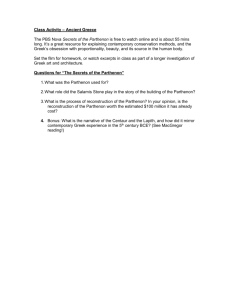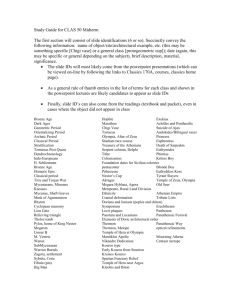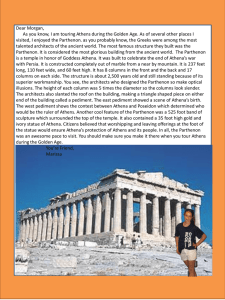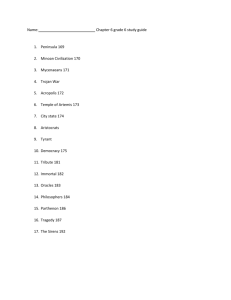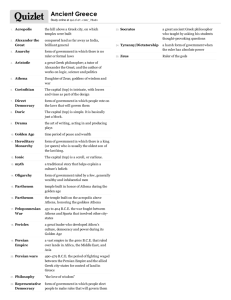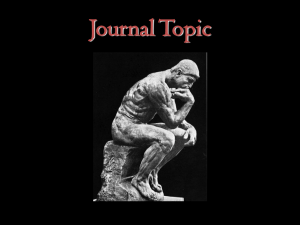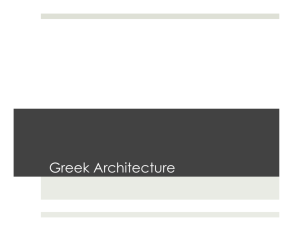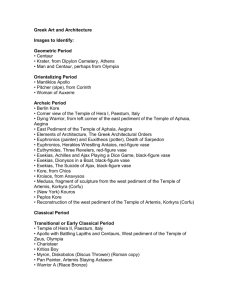CHAPTER 5 The Art of Ancient Greece Multiple
advertisement
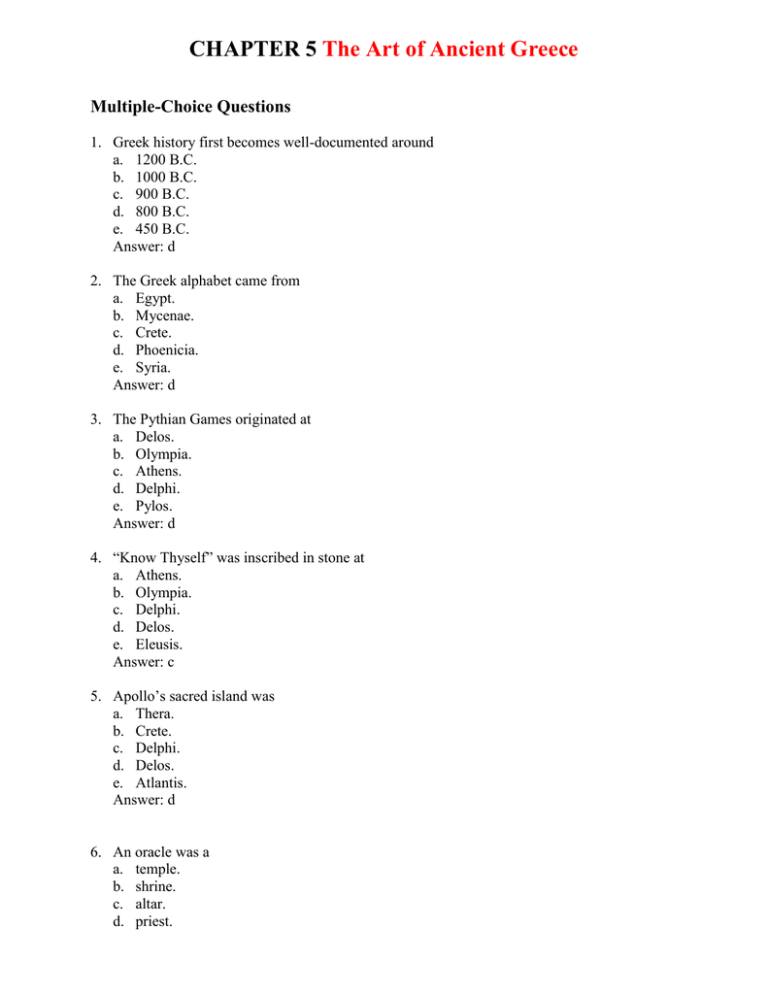
CHAPTER 5 The Art of Ancient Greece Multiple-Choice Questions 1. Greek history first becomes well-documented around a. 1200 B.C. b. 1000 B.C. c. 900 B.C. d. 800 B.C. e. 450 B.C. Answer: d 2. The Greek alphabet came from a. Egypt. b. Mycenae. c. Crete. d. Phoenicia. e. Syria. Answer: d 3. The Pythian Games originated at a. Delos. b. Olympia. c. Athens. d. Delphi. e. Pylos. Answer: d 4. “Know Thyself” was inscribed in stone at a. Athens. b. Olympia. c. Delphi. d. Delos. e. Eleusis. Answer: c 5. Apollo’s sacred island was a. Thera. b. Crete. c. Delphi. d. Delos. e. Atlantis. Answer: d 6. An oracle was a a. temple. b. shrine. c. altar. d. priest. e. magician. Answer: d 7. Which of the following was NOT a famous woman in ancient Greece? a. Sappho of Lesbos. b. Iaia of Kyzikos. c. Aspasia. d. Artemisia. Answer: d 8. Greek Geometric art was seen in the a. 9th century B.C. b. 7th century B.C. d. 6th century B.C. d. 5th century B.C. Answer: a 9. The lively, rectilinear meander patterns circling the body of a vase is typical of a. changes from the Archaic to Hellenistic style. b. the Geometric style. c. the Classical style. d. the Orientalizing style. Answer: b 10. Black-figure pottery is from the a. Geometric period. b. late Classical period. c. Archaic or early Classical period. d. Hellenistic period. Answer: c 11. A nude standing figure of a young man is known in Greek art as a(n) a. kore. b. entasis. c. lapith. d. kouros. Answer: d 12. A Greek two-handled storage jar is known as a(n) a. hydria. b. kylix. c. krater. d. amphora. Answer: d 13. A Greek drinking cup was called a(n) a. krater. b. amphora. c. lekythos. d. kylix. Answer: d 14. The Classical Greek style can best be described as a. stylized and organic. b. stylized and idealized. c. figurative and non-representational. d. idealized but non-figurative. e. naturalistic but idealized. Answer: e 15. Which best describes Greek government during the Classical period? a. democracy b. autocracy c. tyranny d. monarchy e. aristocracy Answer: a 16. The main Greek media used by sculptors were a. bronze and iron. b. marble and terracotta. c. terracotta and bronze. d. bronze and marble. e. gold and marble. Answer: d 17. Which of the following is NOT a Greek god or goddess? a. Ares b. Artemis c. Hestia d. Poseidon e. Venus Answer: e 18. Which of the following is NOT a correct pairing of Greek god with its Roman counterpart? a. Zeus and Jupiter b. Dionysos and Bacchus c. Demeter and Ceres d. Hades and Hebe e. Athena and Minerva Answer: d 19. Which of the following do NOT belong together? a. Zeus – thunderbolt b. Juno – peacock c. Hephaistos – hearth d. Neptune – trident e. Hermes – caduceus Answer: c 20. Which of the following did NOT take part in the Trojan War? a. Achilles b. Ajax c. Odysseus d. Sophokles e. Agamemnon Answer: d 21. Which of the following is NOT a correct definition? a. hydria – water jar b. amphora – storage jar c. krater – flask for pouring oil d. kylix – drinking cup e. oenochoe – jug for pouring wine Answer: c 22. Which do NOT belong together? a. Exekias – Geometric style b. Myron – Early Classical style c. Polykleitos – Classical style d. Lysippos – fourth century B.C. e. Phidias – Classical style Answer: a 23. Which was NOT a technique or process used by the Greeks? a. lost-wax b. black-figure c. red-figure d. white ground e. mummification Answer: e 24. “Classical” means a. old-fashioned and valuable. b. traditional and of high quality. c. out-of-date and trite. d. traditional and stylized. e. idealized and valuable. Answer: b 25. Contrapposto is a. a twist at the neck. b. a counter position. c. a twist at the waist. d. stepping forward. e. standing at attention. Answer: c 26. The earliest example of the use of contrapposto was in the sculpture of the a. Kouros from Tenea. b. Kritios Boy. c. Laocoön. d. Perikles. Answer: b 27. The Riace bronzes were found in a. Riace. b. a cave. c. the sea. d. a grave. e. a temple. Answer: c 28. Which do NOT belong together? a. volute, shaft, base, flutes b. abacus, volute, base, frieze c. metope, triglyph, abacus, echinus d. abacus, volute, echinus, metope e. stylobate, drum, echinus, metope Answer: d 29. Which set is correct? a. Nike Temple (427–424 B.C.) b. Parthenon (439–419 B.C.) c. Erechtheum (421–405 B.C.) d. Propylaea (480–450 B.C.) Answer: a 30. The general who commissioned the Parthenon was a. Alkiabiades. b. Sophokles. c. Herodotos. d. Xenophon. e. Perikles. Answer: e 31. The supervisor of the sculptural decorative work of the Parthenon was a. Praxiteles. b. Polykleitos. c. Myron. d. Phidias. Answer: d 32. To the Greeks, “barbarians” were a. cannibals. b. Persians. c. Egyptians. d. Scythians. e. foreigners. Answer: e 33. Which is NOT part of the Parthenon plan? a. naos b. treasury c. pronaos d. propylaea e. peristyle Answer: d 34. What subject was portrayed on the frieze around the Parthenon? a. the Great Panathenaic procession b. the Great Dionysiac procession c. the labors of Herakles d. the Battle of Gods and Giants Answer: a 35. The Parthenon metopes represented a. the battle between Greeks and Trojans. b. the battle between Lapiths and Centaurs. c. the battle between the gods and Titans. d. the battle between Greeks and Amazons. e. All these answers are correct. Answer: e 36. Which is NOT a correct pairing? a. pediment – triangle b. metope – trapezoid c. triglyph – vertical d. shaft – cylinder e. architrave – rectangle Answer: b 37. Which is NOT an aspect of Athena? a. virginity b. victory c. fertility d. war e. wisdom Answer: c 38. The statue of Athena in the Parthenon naos was made of a. marble and bronze. b. ivory and bronze. c. ivory and marble. d. gold and marble. e. gold and ivory. Answer: e 39. Which is found in the Parthenon sculptures? a. contrapposto b. isocephaly c. symmetry d. all of these: contrapposto, isocephaly, and symmetry e. None of these answers is correct. Answer: d 40. Which is NOT part of the Erechtheum? a. the Ionic Order b. caryatids c. Doric columns d. an irregular plan Answer: c 41. A female figure used as a column is known as a a. caryatid. b. kore. c. kouros. d. atlantid. Answer: a 42. Greek theater began a. inside of temples. b. outside of temples. c. in the hills. d. by the sea. e. around trees. Answer: c 43. Which is NOT part of Greek theater architecture? a. orchestra b. pronaos c. proscenium d. skene e. parados Answer: b 44. The first known Greek artist to celebrate the female nude was a. Praxiteles. b. Phidias. c. Perikles. d. Lysippos. e. Exekias. Answer: a 45. Demosthenes was a. a tragedian. b. an orator. c. a historian. d. a poet. e. a sculptor. Answer: b 46. Alexander the Great was a. an Athenian. b. a Persian. c. a Pergamene. d. a Macedonian. e. a Mycenaean. Answer: d 47. Winged Victory was found in a. Sparta. b. Athens. c. Macedon. d. Samothrace. e. Rhodes. Answer: d 48. Greek Hellenistic art a. is realistic. b. conveys inner character. c. is more passionate. d. All these answers are correct. Answer: d 49. The priest who warned the Trojans not to bring in the giant wooden horse was a. Herakles. b. Laocoön. c. killed by snakes. d. both Laocoön and killed by snakes. Answer: d 50. Which of the following was NOT a Greek tragedian? a. Aristophanes b. Sophokles c. Aeschylos d. Euripides Answer: a 51. Plato’s spokesman in the Dialogues was a. Perikles. b. Herodotos. c. Sophokles. d. Demosthenes. e. Socrates. Answer: e 52. The Trojan War took place around a. 800 B.C. b. 1000 B.C. c. 1200 B.C. d. 900 B.C. e. 600 B.C. Answer: c 53. Troy was located in a. East Greece. b. the Cyclades. c. Persia. d. Anatolia. e. Mycenae. Answer: d 54. Who wrote the The Oresteia? a. Aeschylos b. Sophokles c. Euripides d. Herodotos e. Plato Answer: a 55. Who wrote The Republic? a. Homer b. Plato c. Socrates d. Perikles e. Herodotos Answer: b 56. Which of the following is true? a. Homer wrote The Laws. b. Plato wrote the Iliad. c. Socrates wrote Dialogues. d. Demosthenes wrote speeches. e. Euripides wrote comedies. Answer: d 57. Which of the following was NOT a Greek sculptor? a. Praxiteles b. Myron c. Phidias d. Polykleitos e. Exekias Answer: e Key Works Temple of Apollo, Delphi, east view, 346–320 B.C. Socrates, 1st or 2nd century A.D., Roman copy of an original by Lysippos Geometric amphora, 8th century B.C. Polyphemos Painter, amphora, 675–650 B.C. Exekias, amphora showing Achilles and Ajax Playing a Board Game, 540–530 B.C. Exekias, amphora showing Achilles and Penthesilea, c. 525 B.C. Berlin Painter, bell krater showing The Abduction of Europa, c. 490 B.C. Penthesilea Painter, cup interior showing Achilles and Penthesilea, c. 455 B.C. Niobid Painter, kalyx krater, side showing unidentified scene, c. 455–450 B.C. Niobid Painter, kalyx krater, side showing Death of the Children of Niobe, c. 455–450 B.C. Reed Painter, Warrior by a Grave (white-ground lekythos), c. 410 B.C. The Battle of Issos, from the House of the Faun, Pompeii, 1st century B.C., after an original Greek fresco of c. 300 B.C. Detail of The Battle of Issos, showing Alexander Detail of The Battle of Issos, showing a dying Persian Terrace of the Lions, Delos, 7th century B.C. New York Kouros, Attica, c. 600 B.C., three views The Cheramyes Master, Hera of Samos, Samos, c. 570–560 B.C. Peplos Kore, c. 530 B.C., two views Attributed to Kritios, Kritios Boy, Acropolis, Athens, c. 480 B.C. Poseidon/Zeus, found in the sea off Cape Artemision, c. 450 B.C. Myron, Diskobolos (Discus Thrower), 460–450 B.C. Warrior from Riace, c. 450 B.C. Polykleitos, Doryphoros (Spear Bearer), c. 440 B.C. Attributed to Polykleitos, Wounded Amazon, c. 430 B.C. Stele of Hegeso, c. 410–400 B.C. View of the Temple of Apollo, Corinth, c. 550 B.C. Reconstruction of the façade of the Siphnian Treasury in the sanctuary of Apollo at Delphi, 530–525 B.C. Seated gods from the Ionic frieze of the Siphnian Treasury After Phidias, Head of Zeus and Enthroned Zeus, 2nd century B.C., obverse and reserve of a coin minted by Hadrian to celebrate the 228th Olympiad in A.D. 133 Apollo with Lapith and Centaur, center of the west pediment of the temple of Zeus at Olympia Athena, Herakles, and Atlas, the Golden Apples of the Hesperides, metope from the east side of the temple of Zeus at Olympia View of Acropolis, Athens East end of the Parthenon, Athens, 447–438 B.C. Reconstruction of the Parthenon, Athens The East Pediment of the Parthenon in 1674, from a drawing by Jacques Carrey, sculptures finished by 432 B.C. Sculptures from the left side of the east pediment of the Parthenon, finished by 432 B.C. Sculptures from the right side of the east pediment of the Parthenon Reconstruction of the three female figures from the right side of the east pediment of the Parthenon Lapith and Centaur, from south metope XXVII of the Parthenon The Parthenon, looking up through the outer Doric peristyle at the Ionic frieze Equestrian group from the north ionic frieze of the Parthenon, c. 442–439 B.C. Reconstruction of Phidias’ Athena, from the naos of the Parthenon, by Neda Leipen and Sylvia Hahn. Original dedicated 438 B.C. Temple of Athena Nike from the east, Acropolis, Athens, 427–424 B.C. Nike Adjusting Her Sandal, from the balustrade of the temple of Athena Nike, 410–409 B.C. The Erechtheum, west side, Acropolis, Athens, 421–405 B.C. The caryatid porch of the Erechtheum, south side Theater at Epidauros, c. 350 B.C. Praxiteles, Aphrodite of Knidos, c. 350 B.C. Lysippos, Apoxyomenos (Athlete with a Strigil), marble, Roman copy of a bronze original of c. 320 B.C. (two views) Attic grave stele, near Athens, c. 350–330 B.C. Head of Alexander, Pergamon, c. 200 B.C. (two views) Polyeuktos, Demosthenes, c. 280 B.C. Winged Nike (Winged Victory), Samothrace, c. 190 B.C. Aphrodite of Melos (Venus de Milo), c. 150–125 B.C. Boy Wrestling with a Goose, c. 150 B.C. Sleeping Eros, c. 150–100 B.C. Boxer, 2nd or early 1st century B.C. Laocoön and his Two Sons, 2nd century B.C.–1st century A.D., Roman copy Altar of Zeus, west front, reconstructed and restored, Pergamon, c. 180 B.C. Athena Battling with Alkyoneus, from the great frieze of the Pergamon Altar, east section, c. 180 B.C. Maps, Diagrams, and Projections Map of ancient Greece, the Aegean Islands, and the eastern Mediterranean Greek vases media and techniques The lost-wax process Plan of the temple of Apollo at Corinth Doric, Ionic, and Corinthian Orders Sectional drawing of the temple of Zeus at Olympia, 465 – 457 B.C., showing the cult statue seen from the façade Reconstructed east façade of the temple of Zeus at Olympia Plan of the temple of Zeus at Olympia Reconstruction drawing (after Studniczka) of the east pediment of the temple of Zeus at Olympia Reconstruction drawing (after Treu) of the west pediment of the temple of Zeus at Olympia Diagrams of the west and east ends of the naos from the temple of Zeus, showing the Labors of Herakles Plan of the Acropolis, Athens Plan of the Parthenon, Athens Cutaway perspective drawing (after G. Niemann) of the Parthenon showing the Doric and Ionic friezes and a pediment Plan of the theater at Epidauros. Key Terms abacus acanthus agora amphora architrave balustrade black-figure canon caryatids cella colonnade contrapposto Corinthian cornice Doric drum echinus egg-and-dart encaustic entablature entasis finial flutes, fluting foreshortening frieze geometric hydria Ionic isocephaly, isocephalic kore kouros krater kylix leaf-and-dart lekythos lost-wax bronze casting (cire-perdue) meander pattern metope naos necking oenochoe Order pediment peripteral peristyle portico protome, protoma red-figure scroll shaft slip stoa stylobate tesserae triglyph volute white-ground

